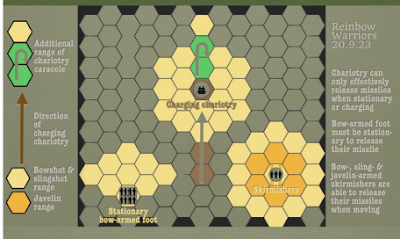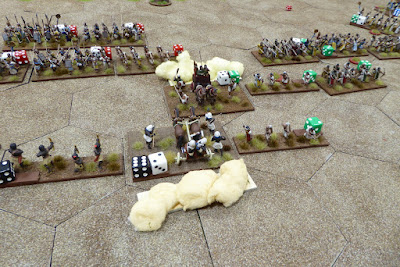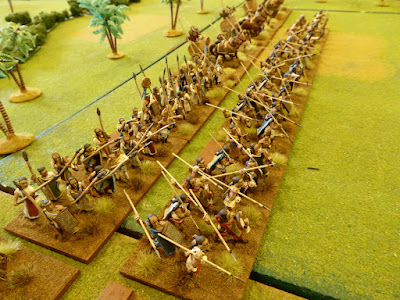As mentioned in the previous post, I joined Ian for a playtest session to refresh my fading memories on rules' development for his Rein-Bow Warriors (RBW) project. Last time we gave the rules a workout was about 18 months ago. What has changed, what do we remember, what have we forgotten, and what can be improved? We will see.
Following is a collection of my notes, insights, and suggestions from this session on Thursday. Next time I look for my notes, I will know where to find them. All tables and illustrations are copyright Ian Russell Lowell. Game photos are mine.
Turn Sequence
The Turn Sequence from the last playtest back in March 2022 contained a total of nine steps. I recall, at the time, that these nine steps were difficult to keep in mind. Some of the steps seemed out of order and the sequence required constant referral during play. Simplification, if possible, would be helpful to streamline the turn sequence. When Ian sent an updated QRS, I noticed that the sequence had been reduced to seven steps. That is good! Seven steps are more manageable than nine.Since Step 3 is a direct result of Step 2, Step 3 could be combined within Step 2. Now we are down to six steps.
 |
| Turn Sequence |
Similarly, Step 6 covers completion of charge movement in addition to hand-to-hand combat. With chariots making their final charge movement in Step 6, frontline foot units ought to take a Reaction Test here as well. We ought to name these Reaction Tests from chariot proximity "Seeing the Chariot" Test. More on this Reaction Test later.To Grid or Not To Grid?
In last year's playtests, battles were fought on an open field with tape measure and protractor in hand. With my game table already laid out with a hex grid from my recent Punic War games, I asked if trying the game on a grid was possible. Ian, said, "Sure!" Within a very short amount of time, a hex-based diagram arrived into my Inbox. All missile ranges and movements rates were converted from inches (or IKU) to hexes.
 |
| Missile ranges and arcs of fire template |
I replied that this looked terrific but my units face a hex vertex not the side. No problem! Within minutes, a new diagram appeared in my Inbox showing a quick switch to unit orientation. |
| Quick revision to unit orientation. |
Now that a hex was in place, one other change I made from the previous games was to reduce a Basic Maneuver Unit (BMU) from two stands to one stand. Each BMU would occupy one hex. In the earlier version of the rules, one BMU comprised two stands. The BMU had one Mettle Value but each stand within the BMU could shoot and melee independently but all damage was assessed against the BMU. What this meant was that (two stand) BMUs had a lot of combat power but were very brittle.As play began, I quickly realized that the switch to a grid-based, one BMU/hex design simplified much of the game mechanisms. Mechanisms that were fuzzy or unclear in the earlier, open-table sessions became straightforward without ambiguity on a grid. While the basic game engine remained intact, the fog was beginning to lift on how to actually implement Ian's design philosophy into a playable solution.
With Turn Sequence and playing area defined, how did the playtest session progress? What else was surfaced during this session?
The Game
After a lengthy discussion trying to remember how all of the pieces worked and a refresher on the dice roll resolution (roll two dice and add the differential to the largest), we dived into the game. |
| Battle lines drawn. |
With the fast-moving chariots heading out first, contact was quickly made. The trailing dust clouds denote last path taken and represent a No-Man's Land to foot. One tenet of RBW is that chariot pairs engage in dogfights in a swirling "joust" as chariots speed passed one another, turn-about, and re-engage in a series of bowshots. No foot units dare enter this whirlwind of activity.  |
| Chariots race off to meet their adversary. |
While in past games, this area was marked out with a series of ill-defined dust clouds, the benefit of a hex-grid was recognized immediately. Play stopped and we discussed the notion of Zones of Control. In a follow-up email, Ian termed these no-go areas as Non-Chariot Exclusion Zones. I think I will stick with EZOC.
 |
| Non-Chariot Exclusion Zone |
Back to the game.As the chariot arms of both armies scream out in advance of the main battle lines, it is clear that the Egyptians are outgunned. While two of the Egyptian chariots intercept two Hittite chariots and begin dogfights, the two Hittite chariots on the wings advance unopposed. The third Egyptian chariot in the center of the Egyptian battle line moves off toward the Hittite main battle line.
 |
| Chariots engage. |
While the two pairs of opposing chariots dogfight, the Egyptian chariot in the center approaches the Hittite line triggering Seeing the Chariot Mettle Tests. In prior iterations of the RBW, when this test was triggered, the entire battle line had to make the test using the Mettle Value of the highest rated unit in the battle line.Again, play was stopped to discuss.
After an engaging discussion with a few anecdotes told, we decided to only test units that were actually within chariot bow range. Any testing unit could still utilize the highest Mettle Value from the entire battle line. Was a successful Mettle Test based upon less or equal to a dice roll or strictly less than? Less than or equal was the decision. Also, throwing doubles during a Mettle Test resulted in possible leader casualty in the earlier rules' iteration. Now, doubles are treated as a regular Mettle Test (Pass or Fail) with the largest die used since differential is zero. In this game, we used doubles as an automatic pass but think the test ought to remain within the standard framwork as outlined in the previous sentence.
 |
Hittites test for Seeing the Chariot.
Hittite skirmishes are close to breaking. |
On both flanks, chariot dogfighting continues. In previous games, ammo expenditures were tracked. Chariots had four shots before needing to break off and return to camp to replenish. In this game, constraints on ammo supply were lifted. Those previous experiments demonstrated that by the time a chariot had expended its four shots, it was likely already badly damaged. Compounding this, the battle was often decided before chariots could return to camp, replenish, and get back into battle. In this one trial, lifting of ammo supply made no significant difference to the course of battle. Why track something needlessly?  |
| Chariot dogfighting. |
While the dogfighting continues, the Hittites maneuver to get around the Egyptian flanks. The Egyptian foot on the right turn to discourage the attacker from continuing on. The ploy does not work! Despite receiving fire from the massed archers, the Hittite chariot bursts by the foot and heads toward the Pharaoh. Note that the Engagement Chart showed no distinction between bow-armed skirmishers and massed archers. After the game, Ian corrected that to give massed archers an advantage in fire over skirmishing bow. |
| Hittite chariot moves against the Egyptian right. |
 |
| Egyptians turn to face |
 |
| and give the attackers a volley. |
 |
Still, the Hittite sweeps around the flank
and into the Egyptian rear. |
Back in the center, rather than plowing into the Hittite line, the Egyptian chariot pulls up and begins a caracole into the enemy troops. First, the Hittite skirmishers break and run. As the effects of the caracole barrage mount, a unit of javelinmen breaks for the rear. The Hittite line has been breached! Note that after some discussion, a unit of Mettle W1R1 must rout. Otherwise, a unit with Mettle of R1 may remain in place and fight on (defensively only). Earlier, a R1 caused a unit to retire. |
| Hittites break for the rear! |
The Pharaoh is caught behind his battle line and engaged in a dogfight with the enemy chariot. In a series of passes, the Pharaoh is forced to retire. With the Pharaoh fleeing the battlefield, his army does likewise.  |
| Pharaoh is hotly engaged! |
Victory to Ian and his Hittites!This game produced a very interesting battle. We succeeded in exercising many facets of the rules and clarifying a number of points.
I think we made good progress although my tactics need some work.































































